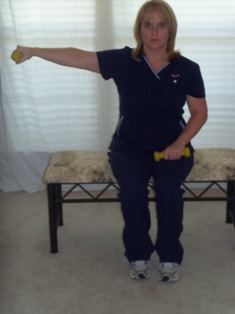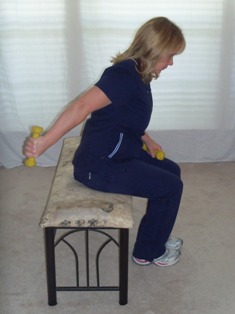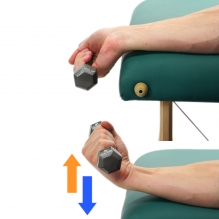Arm Exercises for Strengthening
Medically reviewed by Karen Murray, OT, CHT, CSRS - written by Stroke-rehab.com
|
For a stroke patient that has arm movement but still has residual weakness, there are various arm exercises that can be performed to promote strength and mobility. Some examples include active assistive exercises, isometrics, functional activities and weighted exercises. A description of the different types of exercises is provided below and pictures of resistive exercises can be found further down on this page. |
Active assistive exercises entail the patient performing movements with the affected arm while providing assistance with the unaffected arm as needed. This can include activities such as assisted reaching, lifting, or pushing exercises. You can also use overhead suspension systems, bands, or bungee cords such as the ones below to assist with holding the arm up while performing upper extremity movement.
As an Amazon Associate, I earn from qualifying purchases.
During isometrics, the individual places gentle pressure against a stationary object or their other hand while holding the position for a few seconds. This helps activate the muscles without joint movement.
Functional activities incorporate daily activities into the exercise routine, such as reaching for objects on a table, picking up small items, or folding laundry. These functional activities engage multiple muscle groups. If you are trying to regain movement, it is important to do as many activities as you can with the affected arm to help rewire the brain.
Weighted or resistive exercises to strengthen the arm can be performed with dumbbells or bands for strengthening. Some of these arm exercises for strengthening are demonstrated below.
How Many Repetitions Should You Do for Resistive Exercises?
If someone already has movement and is wanting to work on strengthening, start with one or two sets of 10-15 repetitions and work up to 3 sets performing exercises 2-3x per week. Please check with your physician or therapist first to see if these exercises are appropriate for you. Discontinue any exercises that cause pain. If you are unable to move your arm or are too weak to do these exercises, go to www.stroke-rehab.com/passive-range-of-motion.html for simplified exercise examples.
Shoulder FlexionHold weight in hand (food cans can be used as well). Keeping elbow straight, raise arm overhead and back down. Switch arms and repeat.
 |
Shoulder AbductionHold weight in hand. Keeping arm straight, lift arm out to side to shoulder height. Return arm to side. Switch arms and repeat.  |
Overhead Press
Push arms overhead and back down.
 |
 |
Shoulder External Rotation with Theraband
(Safety Note: Use eye protection in case band breaks)
Holding theraband with hands, start with elbows bent to 90 degrees and against the body. Rotate arms back moving hands out to sides (keep elbows bent to 90 degrees during the movement).
 |
 |
Shoulder Internal Rotation with Theraband
Tie one end of theraband to a doorknob. Pull the other end of the band toward the abdomen keeping the elbow at 90 degrees.
 |
 |
Elbow Extension
Lean forward slightly, hold elbow up behind you, straighten elbow lifting weight behind you then bend elbow. Make sure the elbow stays behind you and that you only move the arm from the elbow down. Switch arms and repeat on other side.
 |
 |
Elbow Flexion
Hold weight in hand. Bend elbow and then straighten elbows. Switch to other side and repeat or you can do both elbows at the same time.

Supination and Pronation
Hold weight in hand with elbow bent to 90 degrees. Turn palm up and down. Keep elbow against side through entire movement.
 "Images by HEP2go.com"
"Images by HEP2go.com"
Wrist Extension
Hold weight in hand with palm facing downward. You can place forearm on table for support or support forearm with other hand. Lift wrist up and down keeping elbow still (wrist movement only).
 "Images by HEP2go.com"
"Images by HEP2go.com"
Wrist Flexion
Hold weight in hand with palm facing up. Support back of forearm on table or support it with your other hand. Lift wrist up and down keeping elbow still (wrist movement only).
 "Images by HEP2go.com"
"Images by HEP2go.com"
Other Arm Exercises for Strengthening
The above exercises are just some examples of simple arm exercises. Strengthening can be performed in many different ways including using one's own body weight, bars, weighted balls, machines, tubing, and more for resistance. Consult with your therapist to learn other ways to do strengthening activities.
Using a personal trainer to learn strengthening exercises is an option as well if given the okay by your physician. To find a personal trainer who has experience in working with clients with health risks or physical limitations, look for a ACSM/NCHPAD Certified Inclusive Fitness Trainer (CIFT). These professionals can be found via a search at the ACSM Pro Finder website (make sure to look for CIFT trainer in search options).
Get Our Stroke Rehab Guide

Our stroke rehab guide is designed specifically for patients and caregivers. It's in pdf format and can be immediately downloaded. It includes about
- Stroke Definition & Causes
- Stroke Treatment
- Rehabilitation Information for Physical, Occupational and Speech Therapy
- Exercise pictures
- Q&A from patients and caregivers
- Adaptive Equipment & Techniques
- How to Prevent Another Stroke & More!
Medical Disclaimer: All information on this website is for informational purposes only. This website does not provide medical advice or treatment. Always seek the advice of your physician or other healthcare provider before undertaking a new healthcare or exercise regimen. Never disregard professional medical advice or delay seeking medical treatment because of something you have read on this website. See the disclaimer page for full information.
- Home
- Arm Strengthening



















